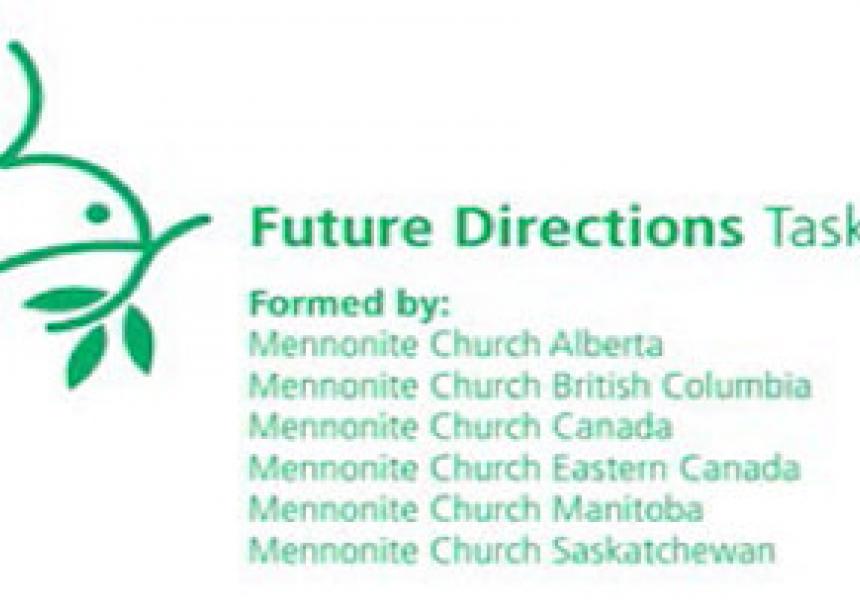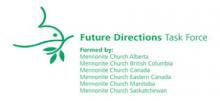Be patient toward all that is unsolved in your heart and try to love the questions themselves. . . Live the questions now. Perhaps you will then gradually, without noticing it, live along some distant day into the answer. —poet and novelist Rainer Maria Rilke
As a Future Directions Task Force working on behalf of the church, we’ve been trying to be patient with this question: “What is God’s Spirit calling us to in the 21st century?” As we seek to live into it, here are some of the myths and the message that engage us.
Myth #1: Future Directions is a Mennonite Church Canada project.
The Task Force was formed by the five area churches across Canada along with the national church. So the Task Force is really Mennonite Church BC, Mennonite Church Alberta, Mennonite Church Saskatchewan, Mennonite Church Manitoba, Mennonite Church Eastern Canada, and Mennonite Church Canada together. It’s about our nationwide church in microcosm acting together.
Myth #2: Future Directions is an evaluation of past and present work.
As we look back, we are grateful for God’s leading and for the good work and sacrificial ministry that has grown the church and impacted the world with the reconciling love and good news of Jesus. Our intention has not been to question decisions of the past or the work of the present. Instead, our focus has been to identify strengths that we can build on and directions for the future. Some things may fade away; some things we have not yet imagined may emerge. New times call for new responses.
Myth #3: The Future Directions final report is a “done deal.”
While the report has been approved in principle by leaders of our area and national church bodies, the document is meant to encourage further conversation as congregations, area churches, and national church continue to discern how we will move into the future together. We hope for much more conversation and further clarification as conference bodies consider and act on the report, as well as thereafter.
Myth #4: Now we can focus on our own congregation and forget about the wider church.
As a Task Force we understand the local congregation as foundational to the church, and our recommendation is to refocus the wider church more clearly on building and resourcing healthy congregations to embody God’s mission. At the same time, a healthy congregation knows its own limitations and benefits from being part of and accountable to a larger body. As a local congregation, we can’t sustain international witness on our own. We can’t train all of our own pastors. We need other congregations to encourage us, to be examples to us, and other congregations need us too.
Myth #5: There will be no more international witness.
While the Task Force report is a public document available online, it also is still an in-house document as congregations, area churches, and national body continue to discern how we will move forward together. In the midst of that conversation, we have not yet been ready for the necessary international conversations, but those will need to happen. Our report recommends that our existing partnerships be given initial priority with the intention of (re-)confirming support for them. In future we envision continuing to work together with our international partners and their discernment of specific needs, grounding Witness more firmly in congregational support and likely with more shorter-term opportunities and unsalaried assignments.
Myth #6: It’s all about money.
The Future Directions Task Force was appointed in response to the growing reality that current programs were not financially or emotionally sustainable in the long run. In this, both national and area churches face similar challenges. But just as a fever is a symptom of something wrong in the body, the budget shortfalls have been a painful symptom. They signal that we need to take another look at what we’re doing. What is our vision? What is our purpose?
Palmer Becker has summarized it this way: “Jesus is the centre of our faith. Community is the centre of our lives. Reconciliation is the centre of our work.”
With this before us, may we be grounded in God’s love, lean into hope and listen to one another. So may we enter into God’s dreams for the future—to reshape and renew the work of the church across the street and around the world. Thanks be to God.
For by him all things were created, in heaven and on earth, visible and invisible, whether thrones or dominions or rulers or authorities—all things were created through him and for him. And he is before all things, and in him all things hold together.—Colossians 1: 16-17
The ten members of the FDTF are Aldred Neufeldt, chair; Hilda Hildebrand, Willard Metzger, April Yamasaki, Chad Miller, Gerald Gerbrandt, Rebecca Steiner, Terry Keller, Ken Warkentin (Manitoba) and Gail Schellenberg.
See also:
Witness workers bring forth concerns about ‘Future Directions’
Witness workers’ concerns acknowledged
A series of editorials:
FDTF: more discernment needed
Are congregations up to it?
Ten years later



Add new comment
Canadian Mennonite invites comments and encourages constructive discussion about our content. Actual full names (first and last) are required. Comments are moderated and may be edited. They will not appear online until approved and will be posted during business hours. Some comments may be reproduced in print.